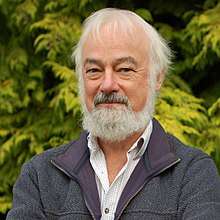Wallace Arthur
Wallace Arthur (born March 30, 1952) is an evolutionary biologist and science writer. He is Emeritus Professor of Zoology at the National University of Ireland, Galway. His most recent book is The Biological Universe: Life in the Milky Way and Beyond, published by Cambridge University Press in 2020, which focuses on the likely extent (how many planets?) and nature (how much like us?) of extraterrestrial life. He was one of the founding editors of the journal Evolution & Development, serving as an editor for nearly 20 years.[1] He has held visiting positions at Harvard University, Darwin College Cambridge, and the University of Warmia and Mazury in Olsztyn, Poland. He is currently Visiting Scientist at Kielder Observatory in Northumberland, England.
Wallace Arthur | |
|---|---|
 Wallace Arthur in 2016 | |
| Born | March 30, 1952 Belfast, Northern Ireland |
| Nationality | British and Irish |
| Alma mater |
|
| Known for | evo-devo, popular science |
| Scientific career | |
| Fields | Evolutionary Biology |
| Institutions | National University of Ireland, Galway |
Early life and education
Wallace Arthur was born in Belfast, Northern Ireland, in 1952. He attended Friends School Lisburn and Campbell College Belfast. He received a BSc in biology from the University of Ulster in 1973 and a PhD in evolutionary biology from the University of Nottingham in 1977.
Scientific work
Arthur describes himself as "a bit of a maverick" who likes "making connections across disciplinary boundaries".[2] His early work was at the interface between evolution and ecology, his later work at the interface between evolution and development, or ‘evo-devo’. His main contributions have been on the origin of animal body plans, the role of developmental bias in evolution, and the evolution of arthropod segmentation. His most recent book explores the interface between biology and astronomy, with two key themes: the likelihood of life having evolved on multiple exoplanets, and the nature of that life being probably not too different to life on Earth.
Arthur is a proponent of a more comprehensive evolutionary synthesis that takes into account progress in the field of evo-devo.[3][4]
Books
- Mechanisms of Morphological Evolution: 1984, Wiley
- Theories of Life: Darwin, Mendel and Beyond: 1987, New York, USA & Harmondsworth, UK publisher Penguin
- The Niche in Competition and Evolution: 1987, Wiley
- A Theory of the Evolution of Development: 1988, Wiley
- The Green Machine: Ecology and the Balance of Nature: 1990, Blackwell
- The Origin of Animal Body Plans: 1997, Cambridge University Press
- Biased Embryos and Evolution: 2004, Cambridge University Press
- Creatures of Accident: The Rise of the Animal Kingdom: 2006, Hill & Wang (Farrar, Straus & Giroux)
- Evolution: A Developmental Approach: 2011, Wiley-Blackwell
- Evolving Animals: 2014, Cambridge University Press
- Life through Time and Space: 2017, Harvard University Press
- The Biological Universe: Life in the Milky Way and Beyond: 2020, Cambridge University Press
Notes
- "Evolution & Development Editorial Board", Evolution & Development, n.d., doi:10.1111/(ISSN)1525-142X
- Ross, Greg (n.d.), "Scientists' Nightstand: Wallace Arthur", American Scientist Online, Sigma Xi: The Scientific Research Society, archived from the original on 2008-08-28, retrieved 3 November 2010
- "Developmental bias: An interview with Wallace Arthur". Extended Evolutionary Synthesis.
- Sommer, Ralf J. (2004). Beyond Darwin – towards an inclusive evolutionary synthesis. Development 131: 5769-5770.